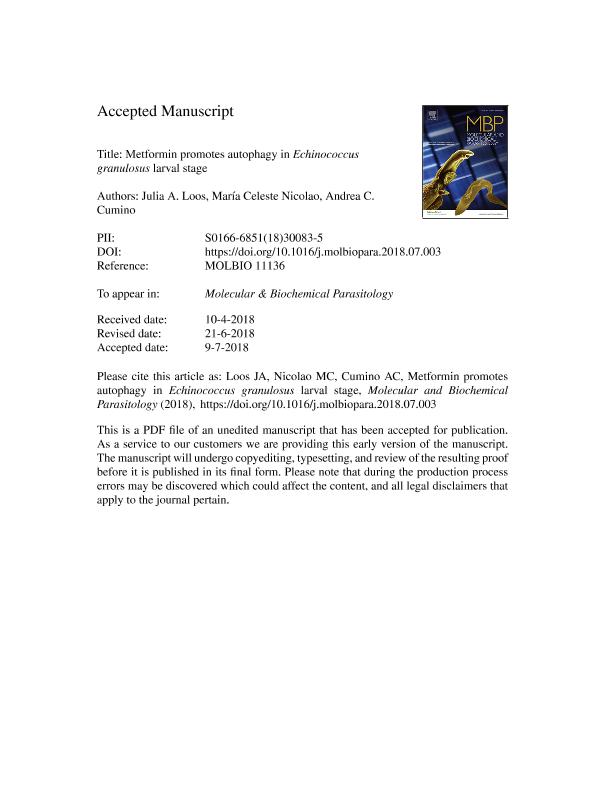Mostrar el registro sencillo del ítem
dc.contributor.author
Loos, Julia Alexandra

dc.contributor.author
Nicolao, María Celeste

dc.contributor.author
Cumino, Andrea Carina

dc.date.available
2019-10-07T18:46:38Z
dc.date.issued
2018-09
dc.identifier.citation
Loos, Julia Alexandra; Nicolao, María Celeste; Cumino, Andrea Carina; Metformin promotes autophagy in Echinococcus granulosus larval stage; Elsevier Science; Molecular and Biochemical Parasitology; 224; 9-2018; 61-70
dc.identifier.issn
0166-6851
dc.identifier.uri
http://hdl.handle.net/11336/85300
dc.description.abstract
Cystic echinococcosis is a neglected parasitic disease caused by the larval stage of Echinococcus granulosus for which an effective treatment is not yet available. Since autophagy constitutes a homeostatic mechanism during stress, either inhibition or activation of its activity might be detrimental for survival of the parasite. Amongst the critical molecules that regulate autophagy, TOR, AMPK and sirtuins are the best characterized ones. Previously, we have identified the autophagic machinery, the occurrence of TORC1-controlled events, and the correlation between autophagy and the activation of the unfolded protein response in E. granulosus larval stage. In addition, we have demonstrated that the parasite is susceptible to metformin (Met), a drug that indirectly activates Eg-AMPK and induces energy stress. In this work, we demonstrate that Met induces autophagy in the E. granulosus larval stage. Electron microscopy analysis revealed the presence of autophagic structures in Met-treated protoscoleces. In accordance with these findings, the autophagic marker Eg-Atg8 as well as the transcriptional expression of Eg-atg6, Eg-atg8, Eg-atg12 and Eg-atg16 genes were significantly up-regulated in Met-treated parasites. The induction of the autophagic process was concomitant with Eg-foxO over-expression and its nuclear localization, which could be correlated with the transcriptional regulation of this pathway. On the other hand, the expression of Eg-AKT and Eg-Sirts suggests a possible participation of these conserved proteins in the regulation of Eg-FoxO. Therefore, through pharmacological activation of the AMPK-FoxO signaling pathway, Met could play a role in the death of the parasite contributing to the demonstrated anti-echinococcal effects of this drug. The understanding of the regulatory mechanisms of this pathway in E. granulosus represents a solid basis for choosing appropriate targets for new chemotherapeutic agents.
dc.format
application/pdf
dc.language.iso
eng
dc.publisher
Elsevier Science

dc.rights
info:eu-repo/semantics/openAccess
dc.rights.uri
https://creativecommons.org/licenses/by-nc-sa/2.5/ar/
dc.subject
AMPK-FOXO SIGNAL PATHWAY
dc.subject
AUTOPHAGY
dc.subject
GLYCOPHAGY
dc.subject
METFORMIN
dc.subject.classification
Bioquímica y Biología Molecular

dc.subject.classification
Ciencias Biológicas

dc.subject.classification
CIENCIAS NATURALES Y EXACTAS

dc.title
Metformin promotes autophagy in Echinococcus granulosus larval stage
dc.type
info:eu-repo/semantics/article
dc.type
info:ar-repo/semantics/artículo
dc.type
info:eu-repo/semantics/publishedVersion
dc.date.updated
2019-09-05T15:30:30Z
dc.journal.volume
224
dc.journal.pagination
61-70
dc.journal.pais
Países Bajos

dc.journal.ciudad
Amsterdam
dc.description.fil
Fil: Loos, Julia Alexandra. Consejo Nacional de Investigaciones Científicas y Técnicas. Centro Científico Tecnológico Conicet - Mar del Plata; Argentina. Universidad Nacional de Mar del Plata; Argentina
dc.description.fil
Fil: Nicolao, María Celeste. Consejo Nacional de Investigaciones Científicas y Técnicas. Centro Científico Tecnológico Conicet - Mar del Plata; Argentina. Universidad Nacional de Mar del Plata; Argentina
dc.description.fil
Fil: Cumino, Andrea Carina. Universidad Nacional de Mar del Plata; Argentina. Consejo Nacional de Investigaciones Científicas y Técnicas. Centro Científico Tecnológico Conicet - Mar del Plata; Argentina
dc.journal.title
Molecular and Biochemical Parasitology

dc.relation.alternativeid
info:eu-repo/semantics/altIdentifier/url/https://linkinghub.elsevier.com/retrieve/pii/S0166685118300835
dc.relation.alternativeid
info:eu-repo/semantics/altIdentifier/doi/https://doi.org/10.1016/j.molbiopara.2018.07.003
Archivos asociados
